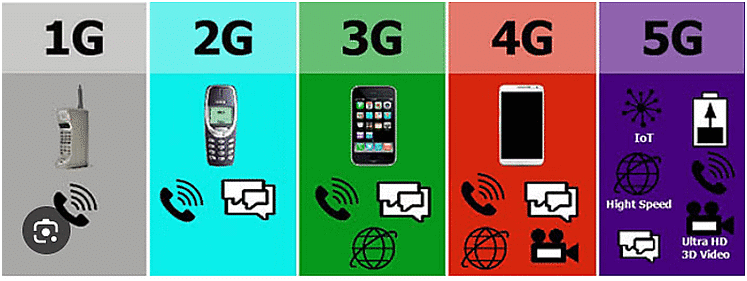SSC CGL Exam > SSC CGL Notes > General Awareness for SSC CGL > Generation of Mobile Phone
Generation of Mobile Phone | General Awareness for SSC CGL PDF Download
Introduction
Mobile phone technology has evolved significantly over the decades, transitioning from early analog systems to sophisticated digital networks. This evolution can be divided into several generations of technology, each offering improvements in speed, efficiency, and functionality.
Generations of Mobile Phone Technology

- First Generation (1G): The original mobile phone systems, often referred to as pre-cellular systems, were based on analog technology and were not as efficient or capable as today's systems. They laid the groundwork for the development of cellular networks.
- General Packet Radio Service (GPRS): GPRS is a packet-switched mobile data service used in 2G and 3G networks, which allows mobile phones to send and receive data in small packets. This technology improved the efficiency of data transmission compared to the earlier circuit-switched models.
Example: GPRS enables basic internet services like web browsing and email on mobile phones. - Enhanced Data rates for GSM Evolution (EDGE): EDGE is a technology that enhances the data transmission speed of GSM networks. It is backward compatible with GSM, meaning it works with existing GSM infrastructure while providing faster data rates.
Example: EDGE allows for quicker web browsing and better multimedia messaging compared to previous GSM technologies. - High Speed Packet Access (HSPA): HSPA combines two protocols—High Speed Downlink Packet Access (HSDPA) for faster download speeds and High Speed Uplink Packet Access (HSUPA) for quicker upload speeds. This technology improves the performance of 3G networks.
Example: HSPA facilitates smoother video streaming and faster file downloads on 3G-enabled devices. - High Speed Packet Access Plus (HSPA+): Also known as HSPA Evolution, HSPA+ is an advanced version of HSPA that offers even higher speeds and better performance. It was first standardized in 3GPP Release 7 and has seen continued enhancements.
Example: HSPA+ supports high-definition video streaming and more reliable data connections compared to standard HSPA. - Long-Term Evolution (LTE): LTE is a standard for high-speed wireless communication, providing significant improvements over previous generations. It is designed for faster data transfer rates and more efficient network use.
Example: LTE enables high-speed internet access, allowing for rapid app downloads, smooth HD video streaming, and improved voice quality. - Voice over LTE (VoLTE): VoLTE allows for high-definition voice calls over LTE networks instead of older 2G or 3G networks. It offers better call quality and faster call setup times.
Example: VoLTE improves the clarity of voice calls and reduces latency compared to calls made over older network types.
Question for Generation of Mobile PhoneTry yourself: Which mobile phone technology allows for high-definition voice calls over LTE networks?View Solution
Other Modes of Communication
- Satellite Radio: Satellite radio transmits analog or digital radio signals via satellites, providing coverage over much larger areas compared to terrestrial FM radio stations.
Example: Satellite radio services like SiriusXM offer a wide range of music and talk channels across various geographical regions. - Satellite Telephone: Satellite phones connect directly to orbiting satellites instead of traditional cell towers. This allows them to work in remote areas where terrestrial network coverage is limited or unavailable.
Example: Satellite phones are commonly used in expeditions and remote locations where conventional cell service is not available. - Wireless Local Loop (WLL): WLL refers to wireless communication systems that connect homes or businesses to the telephone network or the internet without physical wires. It is often used to deliver plain old telephone service (POTS) and broadband internet.
Example: WLL can be used in rural areas where laying physical phone lines is impractical. - Very Small Aperture Terminal (VSAT): VSAT systems use small, dish-shaped antennas to communicate with satellites. They are often used for two-way satellite communication and can be installed on land or maritime platforms.
Example: VSAT technology is used for providing internet access on ships and in remote locations.
The document Generation of Mobile Phone | General Awareness for SSC CGL is a part of the SSC CGL Course General Awareness for SSC CGL.
All you need of SSC CGL at this link: SSC CGL
|
448 videos|1497 docs|288 tests
|
FAQs on Generation of Mobile Phone - General Awareness for SSC CGL
| 1. What are the different generations of mobile phone technology? |  |
Ans. The different generations of mobile phone technology are 1G, 2G, 3G, 4G, and 5G, with each generation offering improvements in speed, connectivity, and features.
| 2. What are some other modes of communication in addition to mobile phones? |  |
Ans. Some other modes of communication in addition to mobile phones include landline phones, email, instant messaging, video calls, and social media platforms.
| 3. How has the generation of mobile phones evolved over time? |  |
Ans. The generation of mobile phones has evolved from basic voice calls in 1G to high-speed internet access and multimedia capabilities in 4G and 5G, allowing for more advanced communication and connectivity.
| 4. What are some key features of each generation of mobile phone technology? |  |
Ans. Each generation of mobile phone technology offers different features, such as improved voice quality in 2G, text messaging in 3G, high-speed data in 4G, and low latency and high capacity in 5G.
| 5. How does the evolution of mobile phone technology impact communication in today's society? |  |
Ans. The evolution of mobile phone technology has greatly impacted communication in today's society by enabling faster, more reliable, and more efficient ways of staying connected with others, accessing information, and conducting business.
Related Searches
















